
Impatiens Downy Mildew: A Curse and Opportunity for Smart Gardeners
DOWNLOADMay 10, 2016 - Rebecca Finneran
Dozens of Michigan gardeners reported last summer that the impatiens in their landscape showed signs of a disease known as downy mildew. To avoid disappointment, they are hoping to make some smart choices for plants this season. This underhanded pathogen can attack plants even when they appear to be growing nicely in the landscape. With the right weather conditions (cool temperatures and plenty of moisture), downy mildew can infect a patch of impatiens seemingly overnight.
A flower bed at the Kent County MSU Extension “Grand Ideas Garden” filled with impatiens, tropical plants and other garden favorites was afflicted this past summer with what we now know to be impatiens downy mildew, a pathogen that has the potential to make a serious footprint in our shady garden for years to come. European gardeners have been dealing with this problem for several years since it can overwinter in the soil.
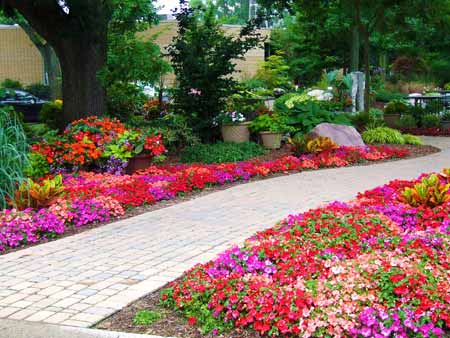
Impatiens at the Grand Ideas Garden before. Photo credit: Rebecca Finneran, MSU Extension
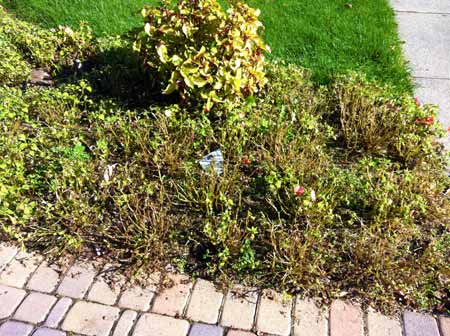
Impatiens at the Grand Ideas Garden infected with downy mildew. Photo credit: Daniel Davis
Impatiens downy mildew infects common and double impatiens, but doesn’t harm New Guinea impatiens or other plants. The disease is favored by moist conditions that are commonly found in an irrigated landscape bed. My first reaction to the sight was I had forgotten to water the plants, but as I inspected the undersides of the leaves where the pathogen resides, I found fuzzy white spores – and didn’t even need my glasses.
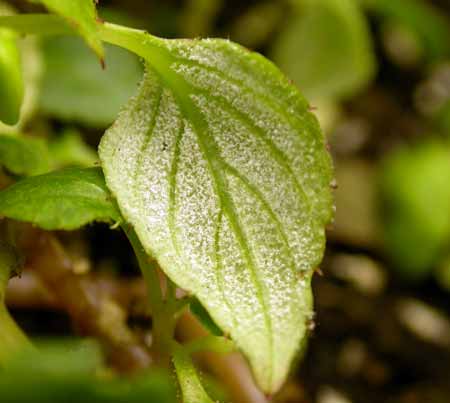
Close-up of a leaf with white fruiting bodies on the underside of the leaf. Photo credit: Mary Hausbeck, MSU
The sky is falling! Well, really it’s not
Even though the impatiens downy mildew pathogen can persist in the soil and keep us from planting Impatiens walleriana cultivars for years, it does cause a gardener or landscape manager to think outside the box and get creative. In truth, the options are endless. Now is the time to be thinking that our cup is half full – no, it’s overflowing with planting possibilities. Gardeners who experienced downy mildew last summer now have a great opportunity to expand both their gardening knowledge and palette as they experiment with new plants.
One of the first things to do is assess the “type” of shade that exists in the garden. A wise professor once said, “Your shade may not be my shade.” In many cases, tree canopies such as that from honey locust (Gleditsia) will allow plenty of bright light through, opening the door to plants we usually consider sun-loving such as Vinca. New Guinea impatiens have a wide adaptability to sun or part shade, but they will do fantastic in morning sun and afternoon shade.
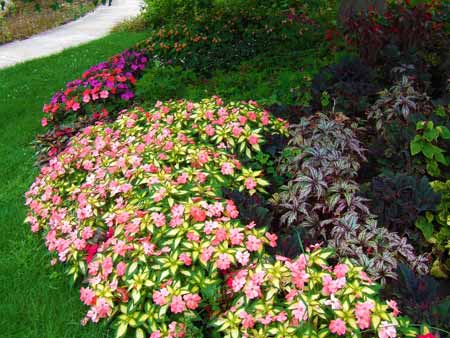
A variegated foliage form of New Guinea Impatiens brightens even the shadiest landscape border. Photo credit: Rebecca Finneran,MSU Extension
Dense shade along the side of a building may also go hand-in-hand with excess moisture and humidity that will limit plants that would rather have a dry location. In this type of planting environment, be sure to site plants that are known moisture lovers. Trees such as maple can create a competitive root environment that requires one to think of alternative ways to grow the plants such as in containers. Once consideration is given to each planting environment around your garden, research the options for getting the right plant into the right place.
So many plants
One of the “bedding plant” mainstays for the coming year will be begonia. With an ever-increasing world- wide search for new plants, the types of begonias that are available today may surprise you. Garden favorites such as the wax begonia come in a wide variety of flower and foliage colors. The perky, upright foliage perfectly positions abundant pink, white or red blossoms launching a great summer show. Because it will only be about 8 to 12 inches in a bed, this one may be a great alternative for a shady garden. Many other begonias have become popular in the last 10 years, partly due to their no-fuss nature. Once established, begonias are not water or nutrient hogs like many other garden plants and they will certainly do well in brighter situations, too.
Don’t miss out on the new lines of big-leaved begonias. Glossy foliage and brilliantly colored blooms are the hallmark of these plants, not to mention they are so easy to grow. Also, the larger and stately “dragon wing” begonias have the added advantage of going into fall with amazing foliage color. As the cooler nights come on, the large, glossy leaves of this plant take on hues of crimson and wine, adding fall interest all the way through October.
Another group of begonias that will be sure to make a splash in the garden due to its brilliantly colored and interesting shaped foliage is Rex begonia. Mottled burgundy to bronze foliage atop chunky stems that seemingly “lift” them up out of a container will make this type of plant shine in your shady landscape.
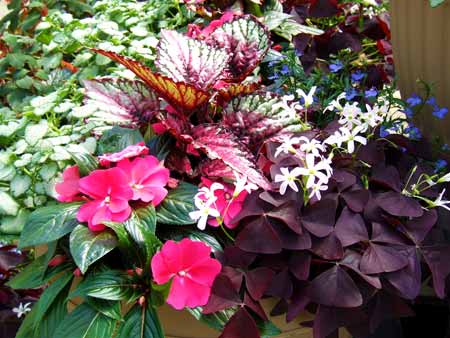
Rex begonias feature rich colors with a unique leaf shape that will compliment other shade plants such as New Guinea impatiens. Photo credit: Rebecca Finneran, MSU Extension
Cane begonias may be a bit harder to find at the local garden center, but will be well worth it. A Victorian era classic, this tough plant may reach 4 feet in height and literally be “dripping” with blooms by the end of summer.
Focus on foliage color
Plants such as Iresine, also known as bloodleaf, and an old garden favorite, the coleus, are sure to brighten up a dark area in your garden. Whether planted in containers or a garden bed, seed-grown coleus offer brilliant foliage colors including chartreuse to white, shades of red and burgundy that will compliment almost any group of plants you choose. Combined with one of the many cultivars of Ipomoea (sweet potato vine), you may have just planted a blue-ribbon combination for part shade!
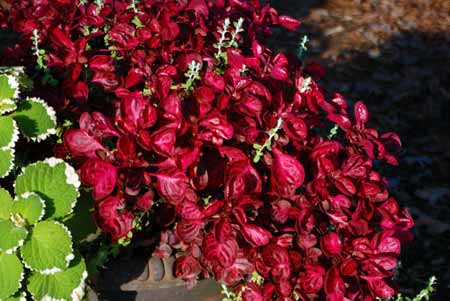
Foliage plants such as Iresine (bloodleaf) will add brilliant color to a shady container. Photo credit: Rebecca Finneran, MSUExtension
These foliage favorites can also be enhanced by a wide variety of tropical plants such as variegated shell ginger and tender perennials including like Caladium.
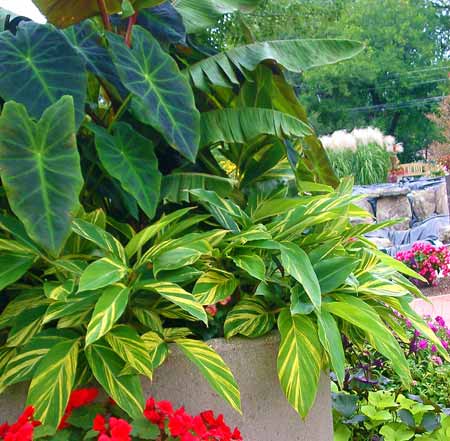
Even colorful tropical plants such as this variegated ginger will make shady sites sizzle all summer. Photo credit: Rebecca Finneran, MSU Extension
To get started, visit MSU’s Alternatives to Impatiens webpage complete with a list of commonly available plants. Because there are so many options, ask your local garden retailer to help you navigate through all the possibilities for shade areas in your garden and look forward to your best shade garden yet.
For more information on a wide variety of smart gardening articles, or to find out about smart gardening classes and events, visit the Gardening in Michigan website.



 Print
Print Email
Email